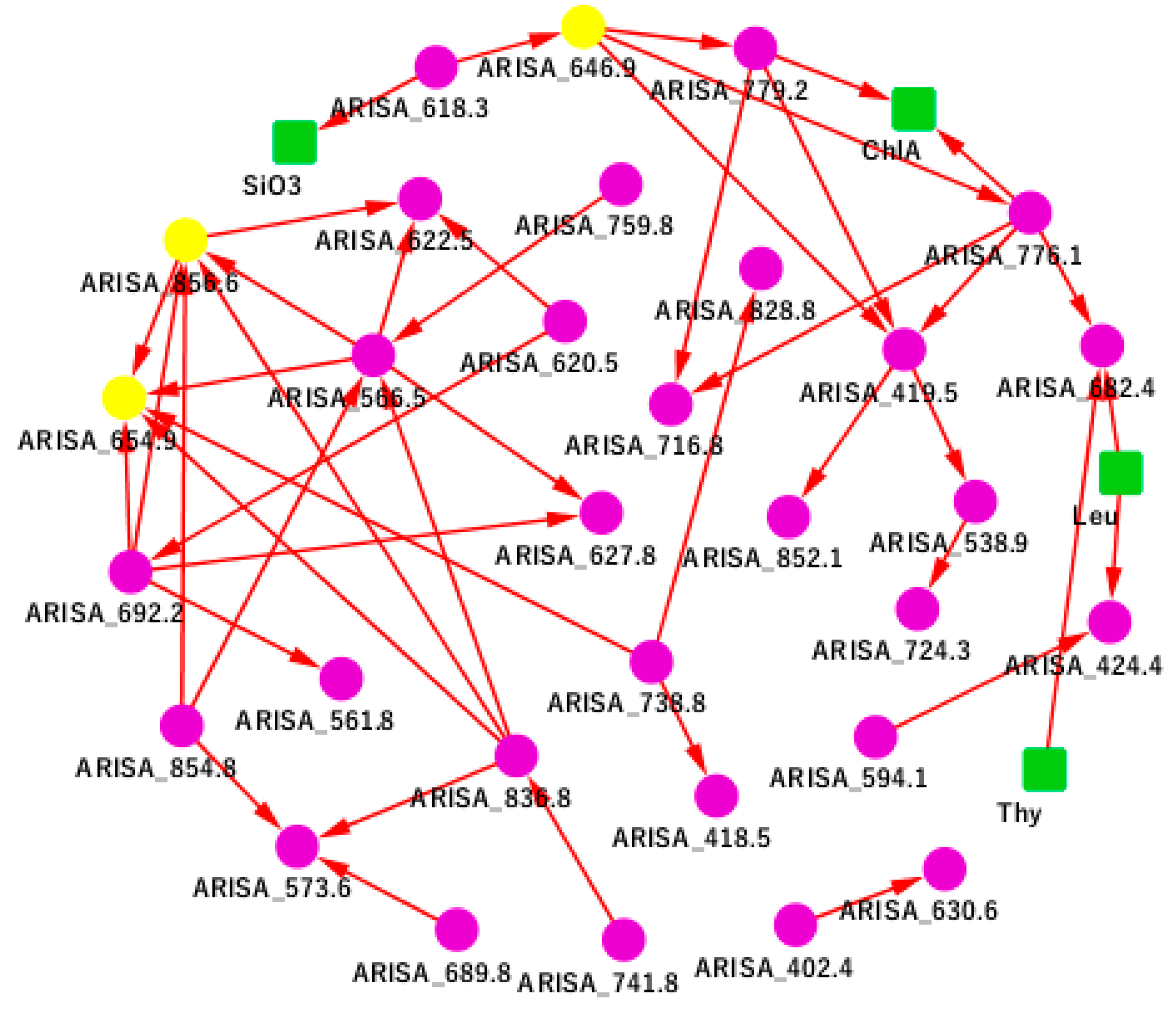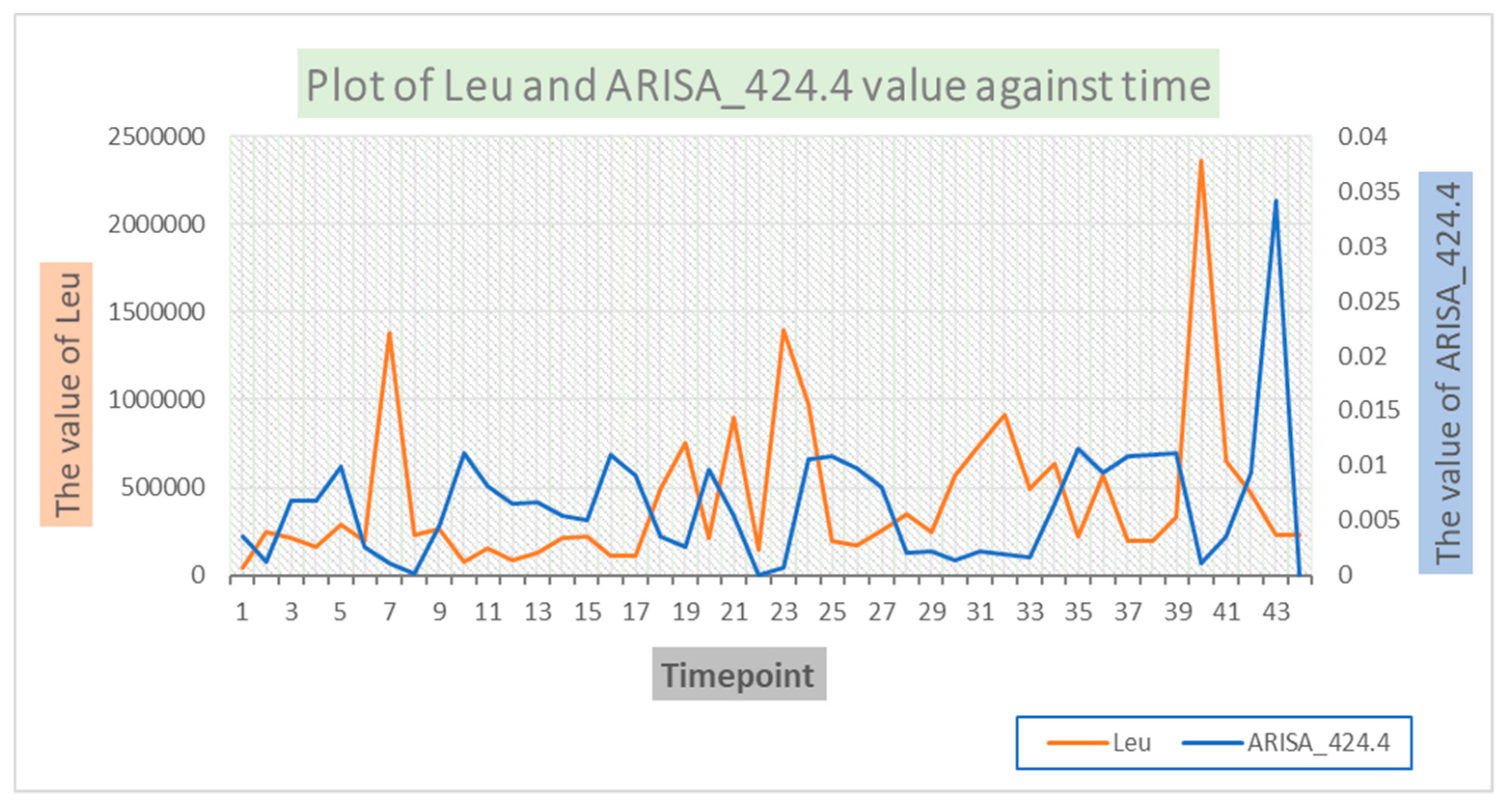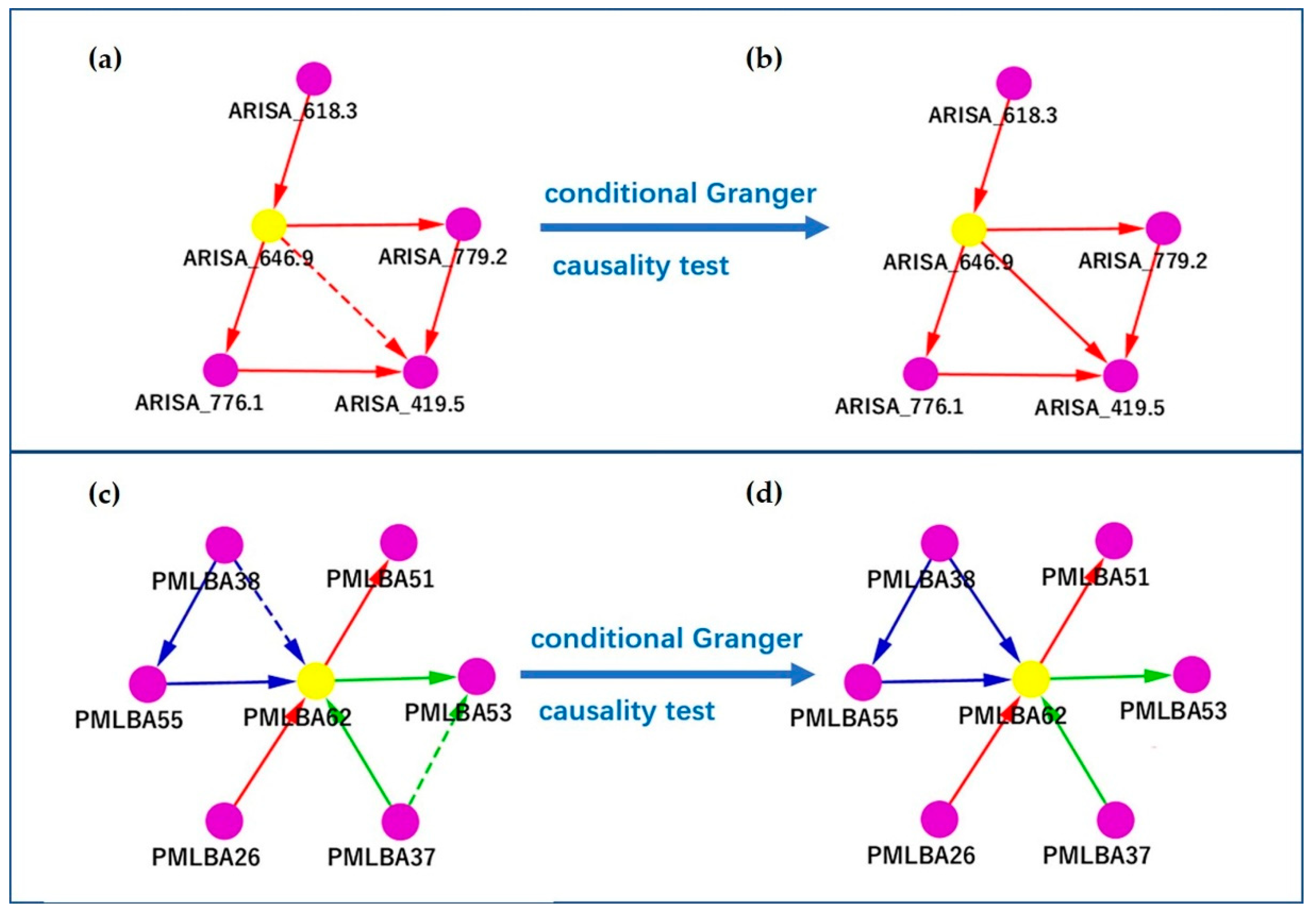Constructing the Microbial Association Network from Large-Scale Time Series Data Using Granger Causality
Abstract
1. Introduction
2. Materials and Methods
2.1. Granger Causality Model
2.2. Statistical Significance of Granger Causality
2.3. Conditional Granger Causality
2.4. Granger Causality Graph
- (1)
- After all pairwise Granger causality tests were done for the system , we generate all the directed edges of graph according the definition of Granger causality graph [25].
- (2)
- We next optimize the graph using the conditional Granger causality:
- We identify the set for all variables .
- We construct the triplet , where
- We perform a conditional Granger causality analysis of and remove the edge from X to Y if any spurious indirect causality was identified (see Equations (7) and (8)).
- (3)
- We output the updated with all spurious edges removed, which satisfies the requirements of the standard Granger causality graph [25].
2.5. Marine Microbial Time Series Datasets
3. Results
3.1. The Marine Microbial Causality Network Based on SPOT Data
3.2. The Marine Microbial Causality Network Based on PML Data
3.3. Removing Spurious Causal Relationship Using the Conditional Granger Causality
4. Discussion and Conclusions
Supplementary Materials
Author Contributions
Funding
Acknowledgments
Conflicts of Interest
References
- Curtis, T.P.; Sloan, W.T.; Scannell, J.W. Estimating prokaryotic diversity and its limits. Proc. Natl. Acad. Sci. USA 2002, 99, 10494–10499. [Google Scholar] [CrossRef] [PubMed]
- Faust, K.; Lahti, L.; Gonze, D.; De Vos, W.M.; Raes, J. Metagenomics meets time series analysis: Unraveling microbial community dynamics. Curr. Opin. Microbiol. 2015, 25, 56–66. [Google Scholar] [CrossRef] [PubMed]
- Fuhrman, J.A.; Hewson, I.; Schwalbach, M.S.; Steele, J.A.; Brown, M.V.; Naeem, S. Annually reoccurring bacterial communities are predictable from ocean conditions. Proc. Natl. Acad. Sci. USA 2006, 103, 13104–13109. [Google Scholar] [CrossRef] [PubMed]
- Gilbert, J.A.; Steele, J.A.; Caporaso, J.G.; Steinbrück, L.; Reeder, J.; Temperton, B.; Huse, S.; McHardy, A.C.; Knight, R.; Joint, I. Defining seasonal marine microbial community dynamics. ISME J. 2012, 6, 298. [Google Scholar] [CrossRef] [PubMed]
- Giovannoni, S.J.; Vergin, K.L. Seasonality in ocean microbial communities. Science 2012, 335, 671–676. [Google Scholar] [CrossRef] [PubMed]
- Kolenbrander, P.E.; Andersen, R.N.; Blehert, D.S.; Egland, P.G.; Foster, J.S.; Palmer, R.J. Communication among oral bacteria. Microbiol. Mol. Biol. Rev. 2002, 66, 486–505. [Google Scholar] [CrossRef] [PubMed]
- Palmer, C.; Bik, E.M.; DiGiulio, D.B.; Relman, D.A.; Brown, P.O. Development of the human infant intestinal microbiota. PLoS Biol. 2007, 5, e177. [Google Scholar] [CrossRef]
- Van Mooy, B.A.; Devol, A.H.; Keil, R.G. Relationship between bacterial community structure, light, and carbon cycling in the eastern subarctic North Pacific. Limnol. Oceanogr. 2004, 49, 1056–1062. [Google Scholar] [CrossRef]
- Barberán, A.; Bates, S.T.; Casamayor, E.O.; Fierer, N. Using network analysis to explore co-occurrence patterns in soil microbial communities. ISME J. 2012, 6, 343. [Google Scholar] [CrossRef]
- Faust, K.; Sathirapongsasuti, J.F.; Izard, J.; Segata, N.; Gevers, D.; Raes, J.; Huttenhower, C. Microbial co-occurrence relationships in the human microbiome. PLoS Comput. Biol. 2012, 8, e1002606. [Google Scholar] [CrossRef]
- Ruan, Q.; Dutta, D.; Schwalbach, M.S.; Steele, J.A.; Fuhrman, J.A.; Sun, F. Local similarity analysis reveals unique associations among marine bacterioplankton species and environmental factors. Bioinformatics 2006, 22, 2532–2538. [Google Scholar] [CrossRef]
- Xia, L.C.; Steele, J.A.; Cram, J.A.; Cardon, Z.G.; Simmons, S.L.; Vallino, J.J.; Fuhrman, J.A.; Sun, F. Extended local similarity analysis (eLSA) of microbial community and other time series data with replicates. BMC Syst. Biol. 2011, 5 (Suppl. 2), S15. [Google Scholar] [CrossRef]
- Granger, C.W.J. Investigating causal relations by econometric models and cross-spectral methods. Econ. J. Econ. Soc. 1969, 37, 424–438. [Google Scholar] [CrossRef]
- Geweke, J. Measurement of linear dependence and feedback between multiple time series. J. Am. Stat. Assoc. 1982, 77, 304–313. [Google Scholar] [CrossRef]
- Akaike, H. Fitting autoregressive models for prediction. Ann. Inst. Stat. Math. 1969, 21, 243–247. [Google Scholar] [CrossRef]
- Wiener, N. The theory of prediction. Mod. Math. Eng. 1956, 1, 125–139. [Google Scholar]
- Guo, S.; Seth, A.K.; Kendrick, K.M.; Zhou, C.; Feng, J. Partial Granger causality—Eliminating exogenous inputs and latent variables. J. Neurosci. Methods 2008, 172, 79–93. [Google Scholar] [CrossRef]
- Bressler, S.L.; Seth, A.K. Wiener-Granger causality: A well established methodology. Neuroimage 2011, 58, 323–329. [Google Scholar] [CrossRef]
- Greene, W.H. Econometric Analysis; Pearson Education India: Chennai, India, 2003. [Google Scholar]
- Geweke, J.F. Measures of conditional linear dependence and feedback between time series. J. Am. Stat. Assoc. 1984, 79, 907–915. [Google Scholar] [CrossRef]
- Goldberger, A.S. Structural equation methods in the social sciences. Econ. J. Econ. Soc. 1972, 40, 979–1001. [Google Scholar] [CrossRef]
- Dahlhaus, R.; Eichler, M. Causality and graphical models in time series analysis. Oxf. Stat. Sci. Ser. 2003, 115–137. [Google Scholar]
- Eichler, M. Granger causality and path diagrams for multivariate time series. J. Econ. 2007, 137, 334–353. [Google Scholar] [CrossRef]
- Eichler, M. Graphical modelling of multivariate time series. Probab. Theory Relat. Fields 2012, 153, 233–268. [Google Scholar] [CrossRef]
- Wei, Y.; Tian, Z.; Chen, Z. Identification and Application of Granger Causality Graphs of Vector Autoregressive Models Using Conditional Mutual Information. Control Theory Appl. 2011, 28, 979–986. [Google Scholar]
- Steele, J.A.; Countway, P.D.; Xia, L.; Vigil, P.D.; Beman, J.M.; Kim, D.Y.; Chow, C.-E.T.; Sachdeva, R.; Jones, A.C.; Schwalbach, M.S.; et al. Marine bacterial, archaeal and protistan association networks reveal ecological linkages. ISME J. 2011, 5, 1414–1425. [Google Scholar] [CrossRef]
- Storey, J.D. A direct approach to false discovery rates. J. R. Stat. Soc. Ser. B (Stat. Methodol.) 2002, 64, 479–498. [Google Scholar] [CrossRef]
- Storey, J.D. The positive false discovery rate: A Bayesian interpretation and the q-value. Ann. Stat. 2003, 31, 2013–2035. [Google Scholar] [CrossRef]
- Shannon, P.; Markiel, A.; Ozier, O.; Baliga, N.S.; Wang, J.T.; Ramage, D.; Amin, N.; Schwikowski, B.; Ideker, T. Cytoscape: A software environment for integrated models of biomolecular interaction networks. Genome Res. 2003, 13, 2498–2504. [Google Scholar] [CrossRef]
- Fortunato, C.S.; Crump, B.C. Microbial gene abundance and expression patterns across a river to ocean salinity gradient. PLoS ONE 2015, 10, e0140578. [Google Scholar] [CrossRef]
- Walker, D.A.; Sivak, M.N.; Prinsley, R.T.; Cheesbrough, J.K. Simultaneous measurement of oscillations in oxygen evolution and chlorophyll a fluorescence in leaf pieces. Plant Physiol. 1983, 73, 542–549. [Google Scholar] [CrossRef]
- Ladwig, N.; Hesse, K.-J.; Van der Wulp, S.A.; Damar, A.; Koch, D. Pressure on oxygen levels of Jakarta Bay. Mar. Pollut. Bull. 2016, 110, 665–674. [Google Scholar] [CrossRef]
- Robert, C.; Chassard, C.; Lawson, P.A.; Bernalier-Donadille, A. Bacteroides cellulosilyticus sp. nov., a cellulolytic bacterium from the human gut microbial community. Int. J. Syst. Evol. Microbiol. 2007, 57, 1516–1520. [Google Scholar] [CrossRef]
- Jensen, H.; Swaby, R. Association between nitrogen-fixing and cellulose-decomposing microorganisms. Nature 1941, 147, 147. [Google Scholar] [CrossRef]
- Dutheil, C.; Aumont, O.; Gorguès, T.; Lorrain, A.; Bonnet, S.; Rodier, M.; Dupouy, C.; Shiozaki, T.; Menkes, C. Modelling N2 fixation related to Trichodesmium sp.: Driving processes and impacts on primary production in the tropical Pacific Ocean. Biogeosciences 2018, 15, 4333–4352. [Google Scholar] [CrossRef]
- Paerl, H. The cyanobacterial nitrogen fixation paradox in natural waters. F1000Research 2017, 6, 244. [Google Scholar] [CrossRef]
- Zehr, J.P.; Mellon, M.T.; Zani, S. New nitrogen-fixing microorganisms detected in oligotrophic oceans by amplification of nitrogenase (nifH) genes. Appl. Environ. Microbiol. 1998, 64, 3444–3450. [Google Scholar]
- Jabir, T.; Jesmi, Y.; Vipindas, P.V.; Mohamed Hatha, A. Diversity of nitrogen fixing bacterial communities in the coastal sediments of southeastern Arabian Sea (SEAS). Deep Sea Res. Part II Top. Stud. Oceanogr. 2018, 156, 51–59. [Google Scholar] [CrossRef]
- Seth, A.K.; Barrett, A.B.; Barnett, L. Granger causality analysis in neuroscience and neuroimaging. J. Neurosci. Off. J. Soc. Neurosci. 2015, 35, 3293–3297. [Google Scholar] [CrossRef]
- Bellucci, G.; Chernyak, S.; Hoffman, M.; Deshpande, G.; Monte, O.; M Knutson, K.; Grafman, J.; Krueger, F. Effective connectivity of brain regions underlying third-party punishment: Functional MRI and Granger causality evidence. Soc. Neurosci. 2016, 12, 124–134. [Google Scholar] [CrossRef]
- Schmidt, C.; Pester, B.; Schmid-Hertel, N.; Witte, H.; Wismüller, A.; Leistritz, L. A multivariate Granger Causality concept towards full brain functional connectivity. PLoS ONE 2016, 11, e0153105. [Google Scholar] [CrossRef]
- Coben, R.; Mohammad-Rezazadeh, I. Neural connectivity in epilepsy as measured by Granger Causality. Front. Hum. Neurosci. 2015, 9, 194. [Google Scholar] [CrossRef] [PubMed]
- Barnett, L.; Barrett, A.B.; Seth, A.K. Misunderstandings regarding the application of Granger causality in neuroscience. Proc. Natl. Acad. Sci. USA 2018, 115, E6676. [Google Scholar] [CrossRef]




© 2019 by the authors. Licensee MDPI, Basel, Switzerland. This article is an open access article distributed under the terms and conditions of the Creative Commons Attribution (CC BY) license (http://creativecommons.org/licenses/by/4.0/).
Share and Cite
Ai, D.; Li, X.; Liu, G.; Liang, X.; Xia, L.C. Constructing the Microbial Association Network from Large-Scale Time Series Data Using Granger Causality. Genes 2019, 10, 216. https://doi.org/10.3390/genes10030216
Ai D, Li X, Liu G, Liang X, Xia LC. Constructing the Microbial Association Network from Large-Scale Time Series Data Using Granger Causality. Genes. 2019; 10(3):216. https://doi.org/10.3390/genes10030216
Chicago/Turabian StyleAi, Dongmei, Xiaoxin Li, Gang Liu, Xiaoyi Liang, and Li C. Xia. 2019. "Constructing the Microbial Association Network from Large-Scale Time Series Data Using Granger Causality" Genes 10, no. 3: 216. https://doi.org/10.3390/genes10030216
APA StyleAi, D., Li, X., Liu, G., Liang, X., & Xia, L. C. (2019). Constructing the Microbial Association Network from Large-Scale Time Series Data Using Granger Causality. Genes, 10(3), 216. https://doi.org/10.3390/genes10030216




